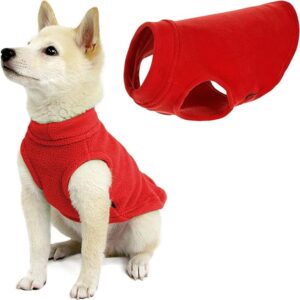There’s an extra chill in the air at the moment. The nights call for extra blankets and hot tea hits the spot more than it normally does. When you cosy up in hoodies and get ready for soup season, take some time to think about how you can best protect your pet from the winter’s chill.
How to prepare your pet for winter
Young, senior, or sick animals
Some pets are naturally equipped to handle winter better than others. Malamutes and Huskies have thick, luscious coats that keep them warm in sub-zero temperatures. For smaller pets and short-haired animals, it can be a struggle. If your pet:
- Is over the age of 10 (or 8 if they’re a large breed)
- Is a puppy/kitten
- Is immunocompromised
- Has joint issues or arthritis
- Has a disease (like Cushing's or hypothyroidism) that prevents even fur growth
You may need to make some extra effort to ensure they’re well-protected from the elements this winter.
Pets with arthritis have vulnerable joints. If they aren't rugged up, their joints can become stiff and sore. Similarly, cold and damp conditions can aggravate their condition. Fit their bed with a hot water bottle or some extra blankets to relieve painful joints.
Puppies and kittens don’t have the fat, metabolism, or luscious fur coat to sustain their body temperature. If you do need to take them outside to go to the bathroom, ensure they’re wearing a jumper or coat to keep warm.
For senior dogs, you might need to adjust your exercise routine to accommodate them. While exercise can encourage good cardio health, be sure to limit walks to no longer than 20 minutes a day.
Upgrade your pet’s bedding
Just as you pull out the extra blanket or the heavy doona to keep yourself warm, add an extra blanket or two to your pet’s bed in the winter months. If you can afford it, think about providing them with a thicker, fluffier bed to keep them warm during the night.
We love the Calming Dog Bed from SAVFOX. They offer a range of different sizes and are all free from formaldehyde, flame retardant materials, and harsh dyes.
Its durable, machine wash safe, and contains premium fibres that retain its shape three times longer than other dog beds.
For old or sick pets, we’d recommend investing in a self-heating pet mat or a microwavable heating pad. It retains your pet’s body heat and ensures they remain warm, even if they don’t have the energy to keep regulating their body temperature.
If you have an outside dog, ensure their living space is clean, dry, and out of the wind and rain. Cozy up their kennel with some extra blankets or straw for additional insulation. If you can, consider bringing them inside on nights when the weather is harsh. A small bed or some blankets in the laundry will do!
Jumpers, jackets, and sweaters, oh my!
Breeds like Golden Retrievers and Samoyeds must be the envy of their peers during winter. Their insulated coats keep them cozy all season long! Short-haired breeds like Greyhounds, Whippets, Dachshunds, and Chihuahuas don’t have this luxury, so you’ll need to get them a jacket.
Look for one that's free of zippers, and is made from a thick but lightweight material. We love the Stretch Fleece Vest from Gooby. Its made of fleece so it's excellent at retaining heat while still being breathable. If you have a dachshund or a dog that's low to the ground, you might find dirt and mud catches onto their sweater. This one is machine washable, so any dirt or muck slides right off. There is no downside to getting your dog or cat a jacket. They look adorable and it keeps them warm.
If you frequently walk or jog no matter the weather, consider getting a rain jacket instead.
Exercise safely
The days are shorter in winter. This means that if you like to take Fido for his walk in the early morning or evening before or after work, you might be out and about in the dark. For maximum safety, we’d recommend getting a high-visibility vest, jacket, or harness to increase your pet’s visibility during low light.
If it’s too cold, wet, and windy to take your pet for walks, try prioritising enrichment activities instead. Mental exercise is just as important as physical exercise! Below are some of our favourite ways to entertain our pets when it’s too wet to walk:
- Do some obedience training
- Play hide and seek
- Throw around a toy, or encourage your cat to use a scratching post or climbing shelf
- Wrap some treats in a tea towel and make a knot. Give the tea towel to your dog and watch them scavenge for the treats.
- Instead of their regular bowl, feed your pet using a snuffle mat or puzzle feeder.
Protect the paws
Winter is more than just a chill in the air and the occasional downpour. If you live in an area that gets snow, pay extra attention to your pet’s paws. Consider getting some booties for your dog to protect against frostbite. Not only do they offer warmth, but they can protect your dog from stepping in any dangerous objects concealed by the snow.
If your dog adamantly protests against booties, avoid any blankets of snow and inspect their paws for any cuts or abrasions after your walk. If you notice your dog’s paw pads are drying out and cracking from the cold weather, consult your vet for a pet-safe moisturiser.
Monitor your pet's temperature
Guinea pigs and mice feel the cold too, though it's a bit harder to put a sweater on them when it gets nippy! To keep them out of the wind and rain, move their enclosure to an undercover area like the patio or a shed if you have one. If you have birds, cover the top of their cage with a blanket to prevent chilly winds and keep them dry.
For other small animals like reptiles or fish, ensure you monitor their enclosure or tank temperature with a thermometer, or consider investing in a lamp or heating system.

Prepare for the worst
Winter can bring extreme, unpredictable temperatures. It’s best to prepare an emergency kit and ensure your pet is covered just in case you need to make a quick getaway. Pack enough food and water for at least five days, as well as any prescription medication and flea/tick preventatives.
Fire safety 101
Cats must own a radar that detects the warmest spots in the house. You’ll often see them chasing wherever the sun is, whether that curled up on a lounge somewhere or on the balcony floor. They also love to sit close to heaters. Be wary of how close your cat sits to the heater or the fireplace. If they fall asleep, they can wake up with dried-out skin or burns. For a safer alternative, place a heating pad in their bedding or their favourite chair.
If you’re lucky enough to own a fireplace, never leave it unattended and open with a pet nearby. Invest in a safety screen to keep your pet and any young children safe from soot, embers, and flames.
Pets and vehicle safety
Cats are also notorious for seeking warmth in car engines. Before starting up your vehicle, honk the horn and check underneath the hood to make sure your cat hasn’t taken a nap in the engine.
While we’re on the topic of pets and vehicles, ensure you keep antifreeze high up and promptly mop up any spills. The taste of antifreeze is sweet to the palette of your furry friends, but ingestion can be fatal. As much as a teaspoon per kg of your pet’s weight is enough to cause dire consequences.
Final word
Even though we aren’t in the trenches of winter yet, there are plenty of things you can do to prepare your pet. Order cosy jumpers, visibility gear for lowlight walks, and ensure their bed is warm enough. Especially if they’re a puppy, a senior, or they have health issues, a warm bed will do them the world of good.


